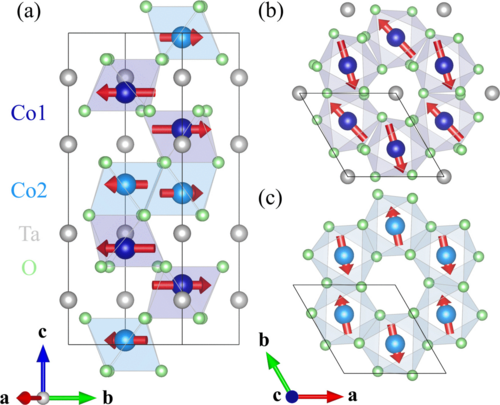In magnetoelectric materials, the magnetic order can be controlled using an electric field or, conversely, the electric polarisation can be controlled using a magnetic field. Developing these materials could lead to a new generation of energy-efficient devices.
One such candidate is Co4Ta2O9 that belongs to a new family of magnetoelectric materials, A4B2O9 (where A = Mn, Fe, Co and B = Nb, Ta). Its magnetoelectric behaviour, however, is uncommon and not previously understood. This study, highlighted by the editors in Physical Review B, utilised single-crystal neutron diffraction on SXD combined with direction-dependent magnetic susceptibility measurements to accurately determine the magnetic structure: key information to explain its magnetoelectricity.
The international group of researchers found that, below 20.3 K, Co4Ta2O9 exhibited unusual long-range antiferromagnetic order, where adjacent spins are pointing in opposite directions. The Co2+ ions form alternating the flat and buckled layers stacked along the vertical c-axis, with the magnetic moments lying in the horizontal plane. The buckled arrangement of magnetic ions can be a primary source of moments being aligned at a slight angle to one another, as shown in the figure below.

(a) The refined magnetic structure of Co4Ta2O9 at 15 K. (b) and (c) show the buckled and the flat honeycomb layers, respectively. The magnetic arrangement is canted antiferromagnetic in the former and collinear antiferromagnetic in the latter. The net moment of the two buckled layers in the unit cell is zero. DOI: 10.1103/PhysRevB.102.214404
Surprisingly, this magnetic structure is different to that observed for Co4Nb2O9, a material that takes the same crystal structure. This result is unexpected, as it was thought that the magnetic behaviour of both compounds was due to the Co2+ ions, whereas this difference suggests that nonmagnetic Ta5+/Nb5+ ions may also influence the magnetic property. The scientists carried out symmetry analysis based on the determined magnetic order, which they were able to use to successfully explain why the peculiar magnetoelectricity is seen in Co4Ta2O9.
As a next step, they aim to characterise the microscopic magnetic interactions. Knowledge of these is needed to understand this material better, as they stabilise the long-range magnetic order and may help then scientists understand the observed unconventional magnetoelectric effect.
Dr Sungkyun Choi from Rutgers University, who led the experiment, explains; “In this project, systematic neutron diffraction was essential in determining the subtle non-collinear magnetic order with a zero scattering wave vector. The accurately determined magnetic order made it possible to explain its rare electric polarisation. Our results provide a reliable example that can help future research on exotic phenomena such as the possible quadrupolar excitation and directional dichroism in this family of compounds."
Further information
The full paper can be found online at DOI: 10.1103/PhysRevB.102.214404
